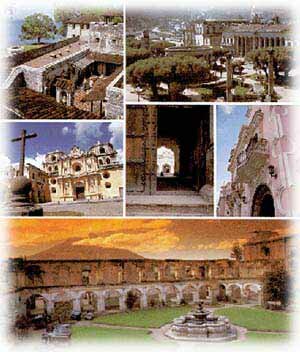
| Spanish French German Italian Russian Chinese Japanese Greek Portuguese Summer Camps |
||
|

|
Home Information Request Form Registration Form Conditions
|
Our Spanish Courses in Guatemala click below : - Antigua
The population is estimated at approximately 11,6 million inhabitants. The Maya people constitute approximately 55 % of the population, roughly 60 percent of the people live in rural zones, and the major part of the population is concentrated in the mountains.
Spanish is the official language, but there are 23 indigenous languages of Maya-quiché origin, for the majority: quiché, cakchiquel, mam, kekchi, pocoman...
The Quetzal.
Among the museums, the Museum of Archaeology and Ethnology of Aurora offers a splendid collection of Maya objects coming from Altiplano and Petén; the museum of the craft industry.
|

Guatemala is a country in Central America, to the south of Mexico, the west of Belize, north of Honduras and El Salvador, and to the east of the Pacific Ocean. Its total surface is 108.889 square kilometers The country is made of three very different geographical areas: the covered coastal plain of forests, plantations and marshes; the mountain which rises brutally to reach 4 000 meters where is the majority of the population concentrated ; after a series of mountainous chains the relief drops to the forest of Petén which resembles Mexican Yucatan. The country is crossed by the Madre Sierra, cordillera which is prolonged by the Andes. Some of its nodes, in the Cuchumatanes mounts rise up to 3 500 meters. It is also the country of volcanoes, one does not count any less than 26, among whom Tacana, Cerro Quemada, De Agua, always in activity, De Fuego, Atitlan and finally Tajamulco with its 4 220 meters whose node is regarded as a place crowned by the Mams Indians.
Several rivers sprinkle the country, most significant is Usumacinta (600 kilometers), its banks were one of the hearths of the Maya civilization. The lakes are very numerous: in the heart of Petén, in a luxurious forest is Petén Itza an imposing monument, near the famous Maya ruins; the lake Atitlan, 1 500 meters of Altitude; the lakes Amatitlan and Izabal. Resources: its forests are the field of hundreds of vegetable species, of which invaluable wood (cedar, mahogany tree), the chicozapote (which is used to manufacture the chewing gum), the palo of hule, the zapotillier... They are populated by many animals: the jaguar, the puma, the ocelot, the hurlor monkey , the tatou and especially the quetzal bird whose feathers change color according to the sun, and are at the origin of the myth of the plumed serpent Quetzalcoatl, one of the gods pre-Colombian.
Guatemala or Ciudad of Guatemala: The capital extends on a plate, with 1500 m of altitude, 80 km off the Pacific Ocean. Half of the industrial production of Guatemala is concentrated there. Founded in 1776 under the name of Santiago de Los Caballeros of Guatemala, after the earthquakes which destroyed the two preceding capitals, Antigua and Ciudad Vieja, it itself was devastated in 1917-1918 by six weeks of earthquakes, and was damaged again in 1976. This modern commercial city, has beautiful shops and a lively market. The national museum of archaeology preserves an impressive collection of objects originally from Mayan sites. The university San Carlos, one of oldest of the Americas, was created into 1676.

|
||||||||||||
|
Map
|
|||||||||||||